Atkinson K. An Introduction to Numerical Analysis
Подождите немного. Документ загружается.

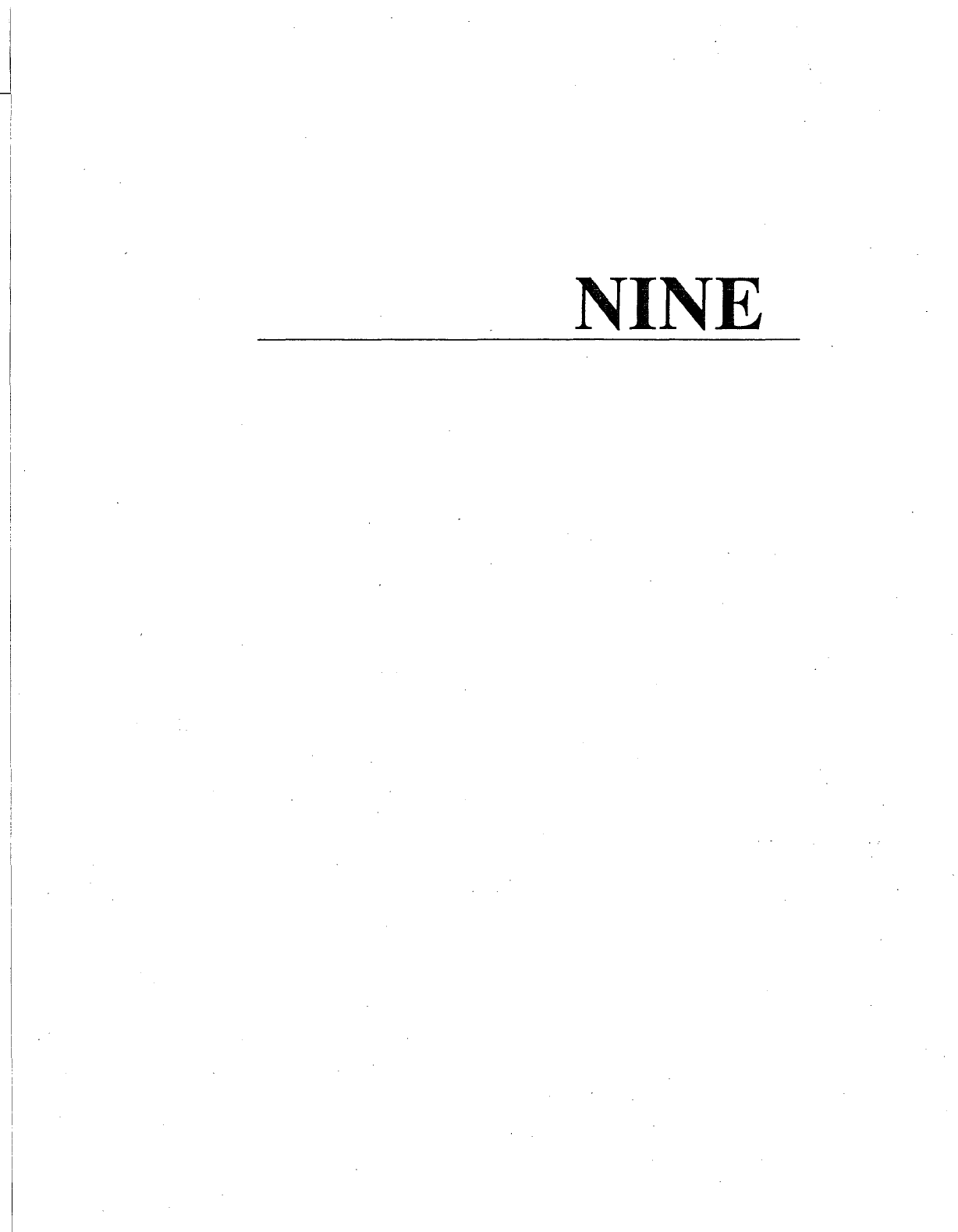
NINE
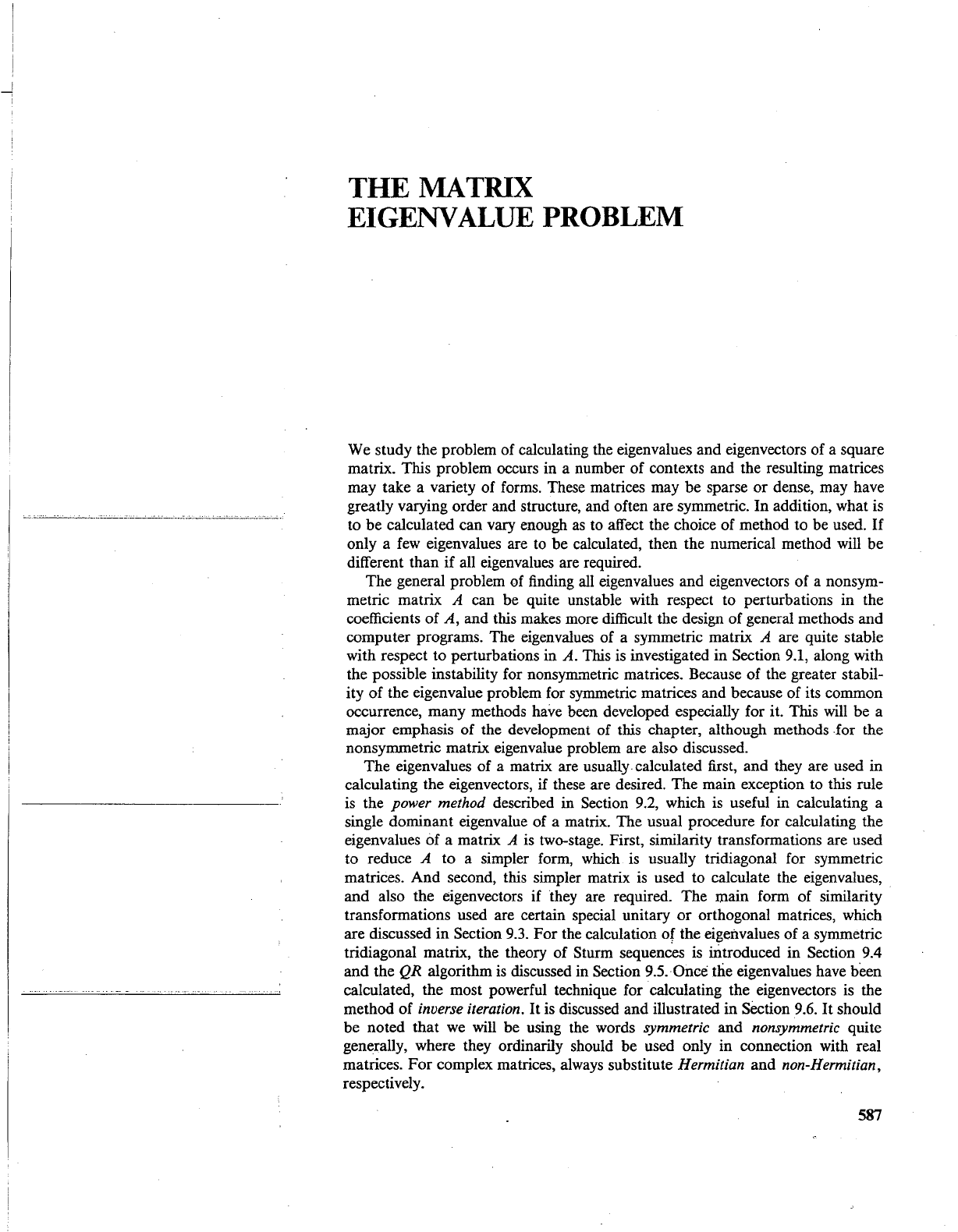
I
:
THE
MATRIX
EIGENVALUE PROBLEM
We study the problem of calculating the eigenvalues and eigenvectors of a square
matrix. This problem occurs in a number
of
contexts and the resulting matrices
may take a variety of forms. These matrices may be sparse
or
dense, may have
greatly varying order and structure, and often are symmetric.
In
addition, what is
to be calculated can vary enough
as
to affect the choice of method to be used.
If
only a few eigenvalues are
to
be calculated, then the numerical method will be
different than if all eigenvalues are required.
The general problem of finding all eigenvalues and eigenvectors
of
a nonsym-
metric matrix
A can be quite unstable with respect to perturbations in the
coefficients
of
A,
and this makes more difficult the design of general methods and
computer programs. The eigenvalues of a symmetric matrix
A are quite stable
with respect to perturbations in
A. This is investigated in Section 9.1, along with
the possible instability for
nonsynll'netric matrices. Because of the greater stabil-
ity
of
the eigenvalue problem for symmetric matrices and because of its common
occurrence, many methods
have been developed especially for it. This will be a
major emphasis of the development of this chapter, although methods .for the
nonsymmetric matrix eigenvalue problem are also discussed.
The
eigenvalues of a matrix are usually.calculated first, and they are used in
calculating the eigenvectors, if these are desired.
The
main exception to this rule
is the
power method described in Section 9.2, which is useful in calculating a
single dominant eigenvalue of a matrix. The usual procedure for calculating the
eigenvalues of a matrix
A is two-stage. First, similarity transformations are used
to reduce
A to a simpler form, which is usually tridiagonal for symmetric
matrices.
And
second, this simpler matrix is used to calculate the eigenvalues,
and also the eigenvectors if they are required. The main form
of
similarity
transformations used are certain special unitary
or
orthogonal matrices, which
are discussed in Section 9.3.
For
the calculation of the eigenvalues of a symmetric
tridiagonal matrix, the theory
of
Sturm sequences is introduced in Section 9.4
and the
QR algorithm
is
discussed in Section 9.5. Once tlie eigenvalues have been
calculated, the most powerful technique for calculating the eigenvectors is the
method of
inverse iteration.
It
is discussed and illustrated in Section 9.6.
It
should
be noted that
we
will be using the words symmetric
and
nonsymmetric quite
generally, where they ordinarily should be used only in connection with real
matrices.
For
complex matrices, always substitute Hermitian and non-Hermitian,
respectively.
587
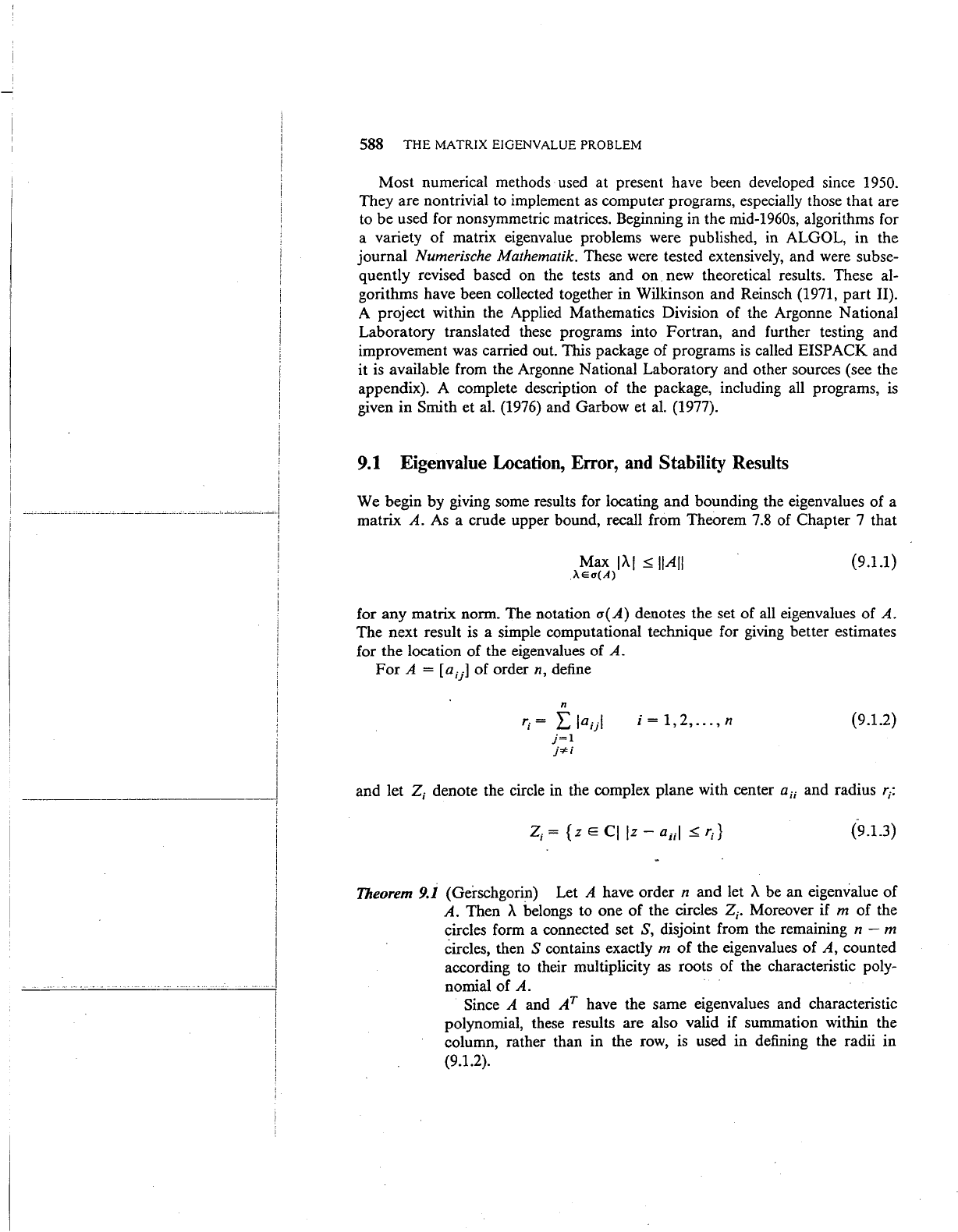
I
I
•••
588
THE
MATRIX EIGENVALUE PROBLEM
Most numerical methods used at present have been developed since 1950.
They are nontrivial to implement
as
computer programs, especially those that are
to be used for nonsymmetric matrices. Beginning
in
the mid-1960s, algorithms for
a variety of matrix eigenvalue problems were published, in ALGOL,
in
the
journal
Numerische Mathematik. These were tested extensively, and were subse-
quently revised based on the tests and on. new theoretical results. These al-
gorithms have been collected together in Wilkinson and Reinsch (1971,
part
II).
A project within the Applied Mathematics Division of the Argonne National
Laboratory translated these programs into Fortran, and further testing and
improvement was carried out. This package of programs
is
called EISPACK and
it
is
available from the Argonne National Laboratory and other sources (see the
appendix). A complete description of the package, including all programs,
is
given in Smith et al. (1976) and Garbow et
al.
(1977).
9.1 Eigenvalue Location,
Error,
and
Stability Results
We begin by giving some results for locating and bounding the eigenvalues of a
matrix
A.
As a crude upper bound, recall from The6rem
7.8
of Chapter 7 that
Max
IAI
~
IIAII
AEo(A)
(9.1.1)
for any matrix norm. The notation
u(A)
denotes the set of all eigenvalues
of
A.
The next result is a simple computational technique for giving better estimates
for the location of the eigenvalues of
A.
For
A =
[aij]
of order n, define
n
r;
= L laijl
j=l
j"'i
i =
1,2,
...
, n (9.1.2)
and let
Z; denote the circle in the complex plane with center au and radius
r;:
(9.1.3)
Theorem
9.i
(Gei:schgorin) Let A have order n and let A be an eigenvalue of
A. Then A belongs to one of the circles Z;. Moreover if m
of
the
circles form a connected set
S, disjoint from the remaining n - m
circles, then S contains exactly m
of
the eigenvalues of A, counted
according to their multiplicity as roots of the characteristic poly-
nomial of
A.
Since A and AT have the same eigenvalues and characteristic
polynomial, these results are also valid if summation within the
column, rather than in the row,
is
used in defining the radii in
(9.1.2).

EIGENVALUE LOCATION, ERROR,
AND
STABILITY RESULTS 589
Figure
9.1 Example of Gerschgorin circle theorem.
Proof
Figure
9.1
gives
a picture in the complex plane of what the circles might
look like for a complex matrix of order three. The solid circles are the
ones given by (9.1.3), and the dotted ones occur later in the proof.
According
to
the theorem, there should be one eigenvalue in Z
3
,
and two
eigenvalues in the union of
zl and
z2.
Let A be an eigenvalue of
A,
and let x· be a corresponding eigenvec-
tor. Let
k be the subscript of a component of x for which
lxkl
= Max lx;l =
llxllco
1 :s;i:s;n
Then from
Ax=
Ax,
the
kth
component yields
n
L akjxj = Axk
j-l
n
(A-
akk)xk = L
akjxj
j=l
j*k
n
lA
-
akkllxkl
~
L lakjl lxjl
~
rkllxllco
j=l
j*k
Canceling
llxllco
proves the first part of the theorem.
Define
·
E=A-D
For 0
~
t:
~
1, define
A(t:)
= D +
t:E
(9.1.4)
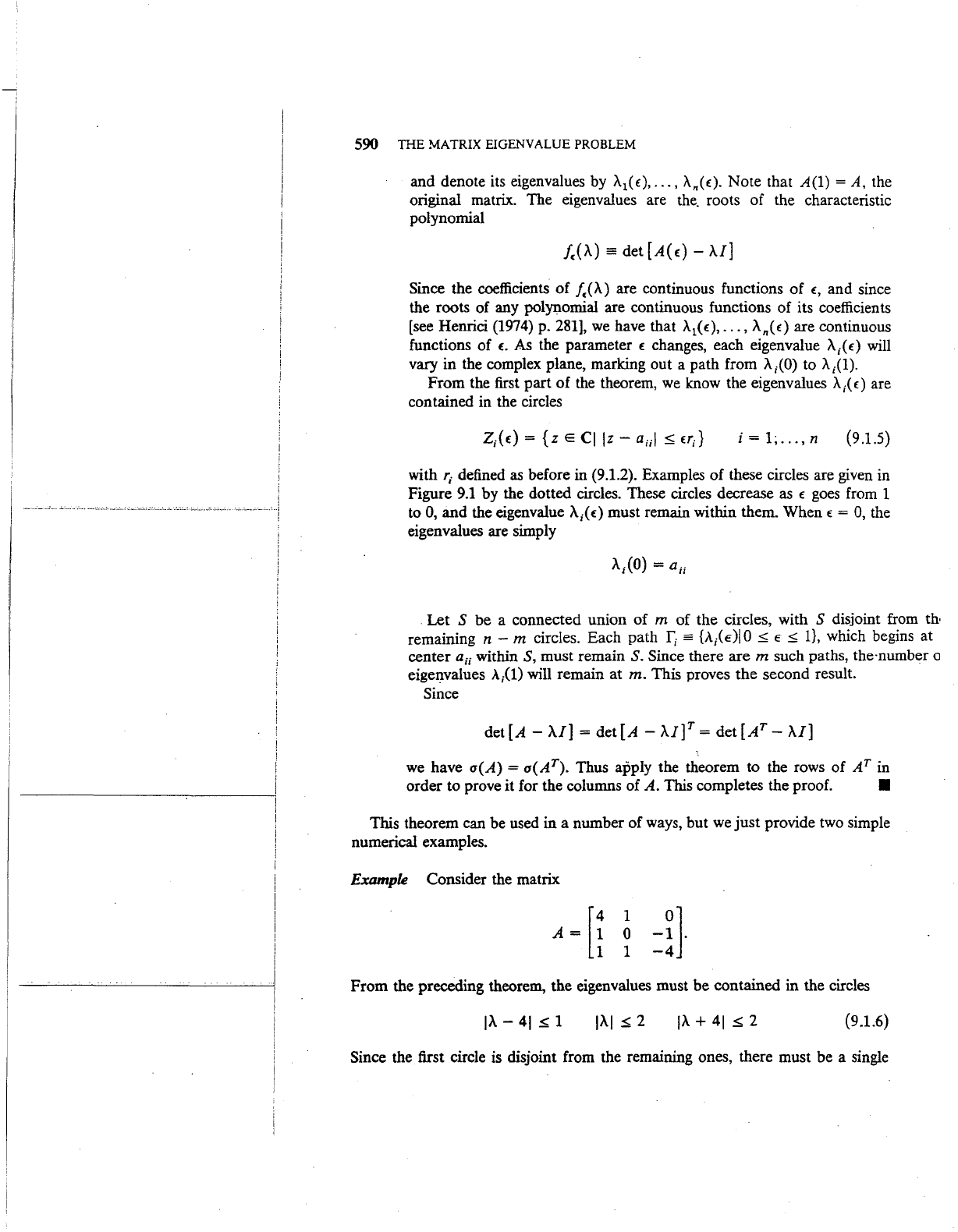
590
THE
MATRIX EIGENVALUE PROBLEM
and denote its eigenvalues
by
A
1
(t:),
...
,
An(t:).
Note that A(l)
=A,
the
original matrix. The eigenvalues are
the.
roots of the characteristic
polynomial
f.(A)
= det
(A(
t:)
-AI]
Since the coefficients of
f..(A)
are continuous functions of
t:,
and since
the roots of any polynomial are continuous functions of its coefficients
[see
Henrici (1974)
p.
281],
we
have that A
1
(t:),
...
,
An(t:)
are continuous
functions
oft:.
As
the parameter
t:
changes, each eigenvalue
A;{t:)
will
vary in the complex plane, marking out a path from
A;(O)
to A;(l).
From the
first
part
of
the
theorem,
we
know the eigenvalues
A;(
t:)
are
contained in the circles
i = 1;
...
, n
(9
.1.5)
with r; defined
as
before in (9.1.2). Examples
of
these circles are given in
Figure
9.1
by the dotted circles. These circles decrease
as
t:
goes
from 1
to
0,
and the eigenvalue
A;(t:)
must remain within them. When
t:
=
0,
the
eigenvalues are simply
Let
S be a connected union
of
m of the circles, with S disjoint from
th·
remaining n - m circles. Each path f; = {.A)dl 0
~
E
~
1},
which begins at
center
au
within S, must
remainS.
Since there are m such paths, the·number o
eige~values
A;(l) will remain
at
m.
This proves the second result.
Since
det
[A-
AI]=
det [A -
A/f
= det
[AT-
A/]
we
have
a(A)
=
a(AT).
Thus apply the theorem to the rows of AT in
order to prove it for the columns of
A. This completes the proof. •
This theorem can be used in a number of ways, but
we
just
provide two simple
numerical examples.
Example Consider the matrix
1
0
1
-~]-
-4
From the preceding theorem, the eigenvalues must be contained in the circles
lA-
41
~
1
lA
+
41
~
2
(9
.1.6)
Since the first circle
is
disjoint from the remaining ones, there must be a single
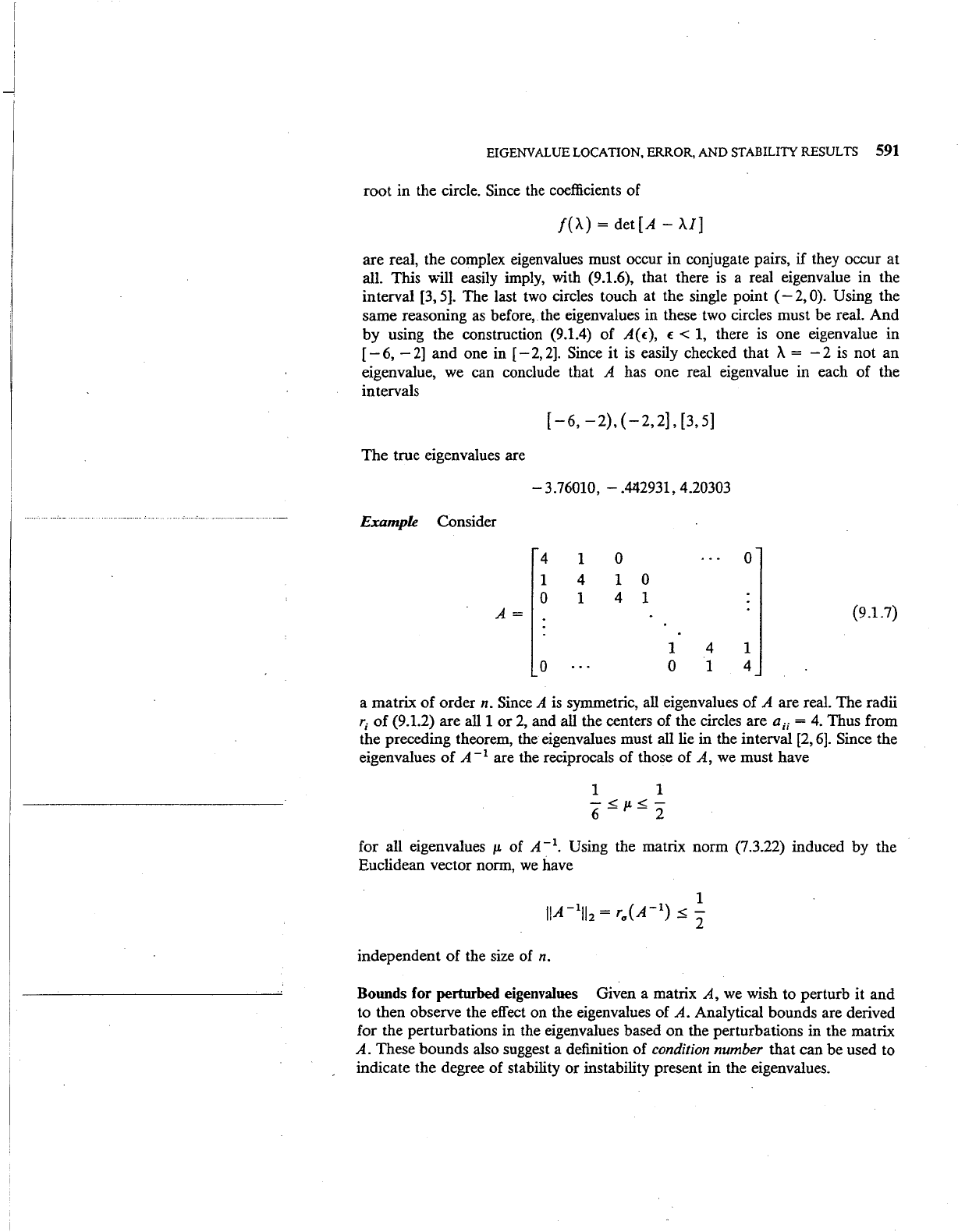
I
I
___)
EIGENVALUE LOCATION, ERROR,
AND
STABILITY RESULTS 591
root
in
the circle. Since the coefficients
of
/("A)=
det[A-
"AA]
are
real, the complex eigenvalues must occur
in
conjugate pairs,
if
they occur
at
all. This will easily imply, with (9.1.6), that there
is
a real eigenvalue in the
interval
[3, 5].
The
last two circles touch
at
the single point
(-
2,
0). Using
the
same
reasoning as before,. the eigenvalues in these two circles
must
be
real.
And
by
using
the
construction (9.1.4)
of
A(t:), £ < 1, there is
one
eigenvalue in
[-
6, -
2]
and
one in
[-
2,
2].
Since
it
is easily checked that
"A
= - 2 is
not
an
eigenvalue, we can conclude that A has
one
real eigenvalue in each
of
the
intervals
The
true eigenvalues are
Example Consider
A=
[
-6,
-2),(
-2,2],
[3,5]
-3.76010,-.442931,4.20303
4
1
0 0
1 4
0 1
0
1 0
4 1
1
0
4
1
1
4
(9.1.7)
a
matrix
of
order
n. Since A is symmetric, all eigenvalues
of
A are real.
The
radii
r;
of
(9.1.2)
are
all1
or
2,
and all the centers
of
the circles
are
a;;=
4. Thus from
the
preceding theorem, the eigenvalues must all lie in the interval [2,
6].
Since
the
eigenvalues
of
A -
1
are the reciprocals
of
those
of
A,
we
must
have
1 1
-<n<-
6-
,..-- 2
for all eigenvalues
p.
of
A -
1
•
Using the matrix
norm
(7.3.22) induced
by
the
Euclidean vector norm, we have
independent
of
the size
of
n.
Bounds for perturbed eigenvalues Given a matrix
A,
we wish
to
perturb it
and
to
then observe the effect
on
the eigenvalues
of
A. Analytical
bounds
are derived
for
the perturbations in the eigenvalues based
on
the perturbations in the matrix
A.
These
bounds
also suggest a definition
of
condition number
that
can
be
used to
indicate
the
degree
of
stability
or
instability present
in
the eigenvalues.

592
THE
MATRIX EIGENVALUE PROBLEM
To simplify the arguments considerably
we
assume that the Jordan canonical
form of
A is diagonal (see Theorem 7.6):
(9.1.8)
for some nonsingular matrix P. The columns of P will be the eigenvectors of A,
corresponding to the eigenvalues
A.
1
,
...
,
A.n.
Matrices for which (9.1.8) holds are
the most important case in practice.
For
a brief discussion of the case in which
the Jordan canonical form
is
not diagonal, see the last topic of this section.
We also need to assume a special property for the matrix norms to be used.
For any diagonal matrix
we
must have that
IIGII
=
Max
!g;l
l.:s;i.:s;n
(9.1.9)
All
of
the operator matrix norms induced by the vector norms
llxiiP'
1
.::;;
p.::;;
oo,
have this property. We can now state the following result.
Theorem 9.2 (Bauer-Fike) Let A be a matrix with a diagonal Jordan canonical
form, as in
(9.1.8). And assume the matrix norm satisfies (9.1.9). Let
A + E be a perturbation of
A,
and let
A.
be an eigenvalue of
A+
E.
Then
Min
!X-
X;!
.::;;
IIPIIIIP-
1
11
IIEII
(9.1.10)
l5:i5:.n
Proof
If
A is ·also an eigenvalue of
A,
then (9.1.10)
is
trivially true. Thus
assume
A.
=I=
A.
1
,
A.
2
,
•••
,
A.n,
and let x be an eigenvector for A + E
corresponding to
A.
Then .
(A+E)x=Ax
(AI-
A)x
=Ex
Substitute from (9.1.8) and multiply by
p-I
to obtain
(XI-
PDP-
1
)x
=Ex
(AI-
D)(P-
1
x)
=
(P-
1
EP)(P-
1
x)
Since
A.
=I=
A.
1
,
.••
,
A.n,
A.
I-
D is nonsingular,
Then
p-
1
x
=(XI-
D)-
1
(P-
1
EP)(P-
1
x)
IIP-
1
xll.::;;
II(A.J-
D)
-
1
11
11P-
1
EP1111P-
1
xll

EIGENVALUE LOCATION, ERROR,
AND
STABILITY RESULTS 593
Canceling
IJP-
1
xll
and using (9.1.9),
This is equivalent to (9.1.10), completing the proof.
•
Corollary
If
A
is
Hermitian, and if A + E is any perturbation of
A,
then
Min
lA-
A;l
~
IIEilz
lsisn
{9.1.11)
for any eigenvalue A of A + E.
•
Proof
Since A
is
Hermitian, the matrix P can be chosen to be unitary. And
using the operator norm
(7.3.19) induced by the Euclidean vector norm,
liPII
2
=
11P-
1
11z
= 1 (see Problem
13
of
Chapter
7).
This completes the
proof.
•
The
statement (9.1.11) proves that small perturbations of a Hermitian matrix
lead to equally small perturbations in the eigenvalues,
as
was asserted
in
the
introduction to this chapter. Note that the relative error in some or all of the
eigenvalues may still be large, and that this occurs commonly when the eigenval-
ues
of
a matrix vary greatly in magnitude.
Example
Consider the Hilbert matrix of order three,
1 1
1
- -
2
3
1 1 1
H3=
- -
2
3 4
{9.1.12)
1
1
1
-
-
3 4
5
Its eigenvalues to seven significant digits are
A
1
= 1.408319 A
2
= .1223271 A
3
= .002687340 (9.1.13)
Now consider the perturbed matrix H
3
,
representing H
3
to four significant digits:
'
[1.000
ii3
=
.5000
.3333
.5000
.3333
.2500
Its eigenvalues to seven significant digits are
xl
= 1.408294
x2
= .1223415
.3333]
.2500
.2000
X
3
= .002664489
(9.1.14)
(9.1.15)
To
verify the validity of (9.1.11) for this case, it
is
straightforward to calculate
IJEii
2
= r,.(E) = t X
10-
4
,;,
.000033

594
THE
MATRIX EIGENVALUE PROBLEM
For the errors and relative errors in (9.1.15),
~\
-
XI
= .0000249
A2
-
x2
= - .oooo144
A3
-
x3
= .oooo229
Rei
(XI)
= .0000177
Rei
(X
2
)
=
-.000118
Rei ( X
3
)
= .0085
All
of
the errors satisfy (9.1.11). But the relative error in X
3
is
quite significant
compared to the relative perturbations in
H
3
•
For
a nonsymmetric matrix A with P
as
in (9.1.8), the number
will be called the condition number for the eigenvalue problem for
A. This is
based
on
the bound (9.1.10) for the perturbations in the eigenvalues
of
the matrix
A when
it
is perturbed. Another choice, even more difficult to compute, would be
to use
K(A)
=Infimum
I!PIIIIP-
1
11
(9.1.16)
with the infimum taken over all matrices P for which (9.1.8) holds and over all
matrix norms satisfying
(9.1.9). The reason for having condition numbers is that
for nonsymmetric matrices
A,
small perturbations E can lead to relatively large
perturbations in the eigenvalues of
A.
Example
To
illustrate the pathological problems that can occur with nonsym-
metric matrices, consider
A=
[101
110
-90]
-98
A+
E =
[101-
t:
110
-90-
(]
-98
The eigenvalues
of
A are A =
1,
2,
and the eigenvalues
of
A + E are
3 -
( ± h -
828t:
+ (
2
A=
2
As
a specific example to
give
better intuition, take
t:
= .001. Then
and its eigenvalues are
A+
E = [100.999
110
-90.001]
-98
A = 1.298, 1.701
(9
.1.17)
(9.1.18)
This problem should not be taken to imply that nonsymmetric matrices are
ill-conditioned. Most cases in practice are fairly well-conditioned. But in writing

EIGENVALUE LOCATION,
ERROR.
AND
STABILITY RESULTS 595
a general algorithm,
we
always
seek
to cover
as
many cases
as
possible, and this
example shows that this
is
likely to be difficult for
the
class of all nonsymmetric
matrices.
For
symmetric matrices, the result (9.1.11) can be improved upon in several
ways. There
is
a minimax characterization for the eigenvalues of symmetric
matrices. For a discussion of this theory and the resultant error bounds, see
Parlett
(1980,
sec.
10.2) or Wilkinson (1965,
p.
101). Instead,
we
give
the
following result, which
will
be more useful for error analyses of methods
presented later.
Theorem 9.3 (Wielandt-Hoffman) Let A and E be real, symmetric matrices of
order n, and define
A=
A + E. Let
A;
and
~;.
i = 1,
...
, n, be the
eigenvalues of
A and
A,
respectively, arranged in increasing order.
Then
(9.1.19)
where
F(E)
is
the Frobenius norm of E, defined in (7.3.10).
Proof
See Wilkinson (1965, pp. 104-:108).
•
This result
will
be
used
later in bounding the effect of the rounding errors that
occur in reducing a symmetric matrix to tridiagonal form.
·
A computable error bound for symmetric matrices Let A be a symmetric matrix '
for which
an
approximate eigenvalue A and approximate eigenvector x have been
computed. Define the residual
1J
=Ax-
Ax
(9.1.20)
Since A
is
symmetric, there
is
a unitary matrix U for which
(9.1.21)
Then
we
will show that
(9.1.22)
Using (9.1.21)
1J
=
UDU*x
-
Ax
U*1J
=
DU*x-
AU*x =
(D-
AJ)U*x
If
A
is
an eigenvalue of A, then (9.1.22)
is
trivially true. Thus there
is
no
loss of
